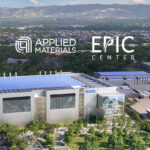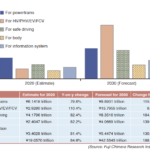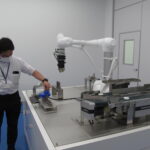ASIA ELECTRONICS INDUSTRYYOUR WINDOW TO SMART MANUFACTURING
Applied's Materials-to-Fab Center to Rise in Arizona
Arizona State University (ASU) and Applied Materials, Inc. entered an alliance that brings more than US$270 million to create a world-class shared research, development and prototyping facility. Specifically, the Materials-to-Fab (MTF) Center, will be established in the university’s MacroTechnology Works building at ASU Research Park. Also, the Arizona Commerce Authority, aids in the consummation of the joint project.
Mainly, the MTF Center aims to accelerate the transfer of innovations from idea creation to fab prototype. It will bring Applied Materials’ state-of-the-art semiconductor manufacturing equipment into a collaborative environment where ASU and Applied Materials can work with industry partners, startups, government entities, and academic institutions. Moreover, the MTF Center will provide students and faculty with opportunities for hands-on learning and research on the same 300mm equipment used in leading-edge production fabs.
Applied Materials is among the largest providers of semiconductor manufacturing equipment. In May, the company announced plans to build the Equipment and Process Innovation and Commercialization (EPIC) Center in California’s Silicon Valley. The EPIC Center will emerge as the heart of a high-velocity innovation platform. Specifically, it includes a network of hubs at leading universities, each focused on materials and process innovation. Moreover, the new MTF Center at ASU will be home to Applied’s Center of Excellence in materials deposition technology.

Accelerate Materials Engineering
“Applied Materials and Arizona State University already enjoy a close partnership. This new alliance around the Materials to Fab Center will take things to a new level,” said ASU President Michael Crow. “But what is more important than the partnership is what it will do for the industry and the country. This is the beginning of a reconfiguration of the way to accelerate discovery and translational research outcomes in response to real world challenges and the development of next-generational processes, materials, equipment, and workforce.”
“Applied Materials is excited to build upon our successful track record of collaboration with Arizona State University by adding the Materials-to-Fab Center to our university innovation network,” said Applied Materials President and CEO Gary Dickerson. “Applied envisions the center at ASU playing a key role in accelerating materials engineering innovations, commercializing academic research and strengthening the pipeline of future semiconductor industry talent.”
Industry-Government-Academia as Key to Success
The design of the MTF Center is already being drafted, and the new lab is expected to be operational within two years. Mainly, the MTF Center project received investments of US$30 million from the Arizona Commerce Authority, US$17 million from ASU, and US$25 million in Arizona New Economy Initiative funding and bonds. Specifically, investments of Applied Materials for the MTF Center might exceed US$200 million. These include capital investments, equipment operation and maintenance, and research and scholarship funding.
“Across the global semiconductor ecosystem, SEMI member companies have expressed the crucial importance of expanding industry workforce development programs to provide the talent pipeline needed for expected growth,” said Ajit Manocha, President and CEO, SEMI.
“Partnerships between industry, academia and governments – such as the collaboration between Applied Materials, Arizona State University and the Arizona state government – will be key to the success of our efforts. We are pleased to offer support with our holistic workforce development program to make the connection from early K-12 STEM learning to community college and university education, to internships, apprenticeships, career training and reskilling.”
Thus, to build an inclusive talent pipeline, Applied Materials also intends to launch an endowment fund that will provide scholarships to first-generation and/or underrepresented minority students in the Fulton Schools of Engineering. In addition, the Applied Materials Momentum Fund will be available to students at ASU. The Momentum Fund provides grants to women pursuing undergraduate degrees in engineering as they approach degree completion, helping to overcome potential financial barriers and accelerating access to careers in the semiconductor industry.
“High-quality universities are one of America’s greatest advantages in the global competition for semiconductor manufacturing, research and development,” said Arizona Governor Katie Hobbs.
“What Applied Materials and Arizona State University are doing is smart. Thus, the successful implementation of the Materials-to-Fab facility will establish an innovation and job creation engine for the semiconductor ecosystem in Arizona.”
Arizona is one of the nation’s key centers of microelectronics activity. It is home to some of the nation’s leading semiconductor producers and suppliers, major defense contractors, world-class universities and research institutes, and a vibrant start-up community. The MTF Center will be an asset to small and large companies across the state and the southwest region and a key capability for connecting ongoing investments in research and manufacturing. It will provide a nexus for academic-industry collaboration in support of the objectives of the CHIPS and Science Act.
“The MTF Center will accelerate the development, commercialization, and manufacturing of next-generation U.S. semiconductor-based technologies while bolstering the state’s infrastructure, workforce, and research capabilities,” said Sandra Watson, President and CEO of the Arizona Commerce Authority. “We’re proud to play a leading role supporting this first-of-its-kind alliance between one of the world’s leading semiconductor technology companies and America’s most innovative university.”
“ASU and Applied Materials have created a foundation of collaboration and we have already seen its value,” said Crow. “What this alliance will do is expand impact, deliver the mechanisms for finding new ways of doing things and, if we are successful, it will yield results that we can use to innovate again. This is work that is never finished. So as exciting as it is to be where we are today, you can expect to hear more from us on this front in the future and we encourage others to take this model and replicate it.”




